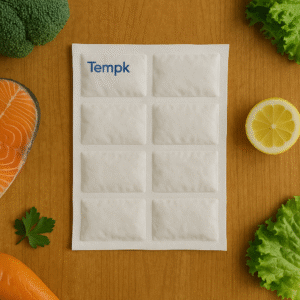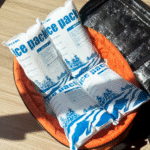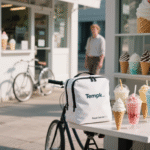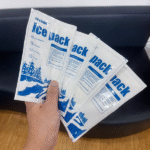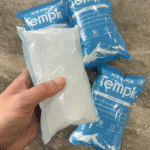Paket icevsice kering: Metode pendingin mana yang harus Anda percayai?
Memilih antara dry ice vs ice packs can feel like a gamble—but the right call cuts spoilage to under 2 % and slashes freight costs by 18 %. This guide shows you when each coolant wins, berapa banyak untuk dikemas, Dan apa 2025 tech is changing the rules.
-
When does an ice pack beat dry ice for 48‑hour deliveries?
-
How much refrigerant keeps goods safe for 24, 48, and 72 hours?
-
What does each option really cost once you add hazmat fees?
-
Yang 2025 innovations extend hold time while shrinking carbon footprints?
-
How can you combine both coolants for maximum flexibility?
When Do Ice Packs Win Over Dry Ice?
Ice packs dominate whenever your product must stay above 0 °C but under 8 °C. They avoid freezer burn, need no hazmat paperwork, and weigh less on short lanes. A quick rule: load packs equal to one‑third the product weight for a 48‑hour run.
Ice packs safeguard chocolate, kosmetik, and vaccines that degrade if frozen. Because they’re reusable and typically curbside‑recyclable, they also tick sustainability boxes.
Everyday Example
-
Craft‑beer club: Three 500 g gel packs around a 4 kg six‑pack kept cans at 5 °C for 36 hours, even in July heat.
Load Calculator: Ice Packs Only
| Muatan (kg) | 24 H Paket (kg) | 48 H Paket (kg) | 72 H Paket + Dorongan es kering |
|---|---|---|---|
| 2 | 0.4 | 0.7 | Add 0.3 kg dry ice |
| 5 | 1.0 | 1.7 | Tambahkan es kering 0,8kg |
| 10 | 2.0 | 3.3 | Tambahkan es kering 1.5kg |
Pre‑chill packs overnight to bump hold time 10 %.
When Does Dry Ice Outperform Ice Packs?
Dry ice is unbeatable for cargo that must stay frozen solid. At –78 °C it absorbs 571 kJ per kilogram as it sublimates, keeping ice cream rock‑hard for up to three days.
Use half the payload weight in dry ice for overnight service, Berat yang sama untuk 48 jam, dan 1,5 × selama 72 jam. Always place dry ice on top—cold sinks.
Real‑World Snapshot
-
West‑coast sushi exporter: 7 kg tuna + 7 kg dry ice delivered at –36 °C after 40 hours door‑to‑door.
Quick Math: Dry Ice Loads
| Muatan (kg) | 24 h Dry Ice (kg) | 48 h Dry Ice (kg) | 72 h Dry Ice (kg) |
|---|---|---|---|
| 5 | 2.5 | 5 | 7.5 |
| 10 | 5 | 10 | 15 |
| 20 | 10 | 20 | 30 |
Paket icevsice kering: Biaya, Keamanan & Compliance Face‑Off
| Faktor | Paket es | Es kering | Apa artinya bagimu |
|---|---|---|---|
| Kisaran suhu | 2–15 ° C. | –78 ° C. | Pilih dengan toleransi produk |
| Regulatory Class | Non‑hazardous | Class9 If > 2.5kg | Affects labels & pelatihan |
| Typical Unit Cost | USD $2.10 /kg | USD $1.25 /kg | Es kering lebih murah per kg |
| Weight Penalty | Low for ≤48 h | High at 1 kg/kg payload | Impacts airfreight fees |
| Pembuangan | Refreeze or recycle | Sublimat ke gas | Plan customer‑safe vents |
Membawa pergi: Ice packs rule the chilled space; dry ice is king for frozen logistics—or blend both for hybrid routes.
2025 Trends Shaping Dry Ice vs Ice Packs Decisions
Di dalam 2025, three breakthroughs are shifting the balance:
-
Plant‑based phase‑change gels add 14 % more latent heat without petrochemicals.
-
Carbon‑negative dry ice sourced from brewery exhaust cuts cradle‑to‑gate CO₂ by 30 %.
-
NFC thermal tags log internal box temps and send alerts via smartphone—ending blind spots.
Market analysts peg hybrid coolant kits to hit US $1.8 B by 2028, driven by meal‑kit and biologic drug demand.
FAQ
How do I stop ice packs from sweating?
Wrap them in absorbent paper or choose sweat‑proof film coatings.
Can I mix dry ice and ice packs?
Yes—place gel packs under the product, es kering di atas. This buffers extreme cold and slows sublimation by up to 20 %.
Is dry ice allowed on passenger flights?
Up to 2.5 kg per box needs only a UN1845 label; di atas itu, full Class 9 paperwork applies.
Ringkasan & Langkah selanjutnya
Memilih antara dry ice vs ice packs boils down to target temperature, waktu transit, and paperwork tolerance. Ice packs excel for chilled goods and simple compliance; dry ice guarantees frozen integrity on long hauls. Use the load tables above, factor 2025 tech upgrades, and test your lanes to lock in sub‑2 % spoilage.
Siap mengoptimalkan rantai dingin Anda?
-
Try our free Coolant Selector quiz.
-
Minta sampel kit (Paket es, dry ice liner, hibrida).
-
Run a pilot shipment and track real‑time temps.
Tentang tempk
We design recyclable thermal packaging that keeps payloads safe without bulky foam. Our AeroFlex™ liners and plant‑based gel packs deliver industry‑leading R‑values while cutting landfill waste 70 %. We staff 24/7 engineers to fine‑tune your lanes.
Book your free consult today.






